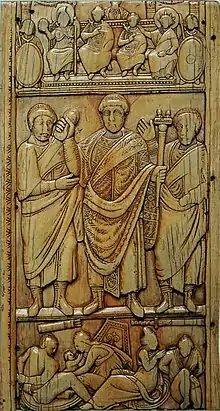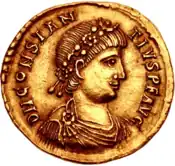Constantius III
Constantius III was briefly Western Roman emperor in 421. He earned his position as Emperor due to his capability as a general under Honorius, achieving the rank of magister militum by 411. That same year, he suppressed the revolt of Constantine III, a Roman general who had declared himself emperor. Constantius then went on to lead campaigns against various barbarian groups in Hispania and Gaul, recovering much of both for the Western Roman Empire. Constantius married Honorius's sister Galla Placidia in 417, a sign of his ascendant status, and was proclaimed co-emperor by Honorius on 8 February 421. He reigned for seven months before dying on 2 September 421.
| Constantius III | |
|---|---|
 Consular diptych of Constantius III | |
| Roman emperor of the West | |
| Reign | 8 February – 2 September 421 (with Honorius) |
| Born | Constantius Naissus, Moesia |
| Died | 2 September 421 Ravenna, Italia |
| Spouse | Galla Placidia |
| Issue | |
| Dynasty | Theodosian |
Life
Early life

Constantius was born in Naissus, Moesia (present-day Niš, Serbia) of Illyrian origin.[1][2][3][4][5] Constantius served as a general under Honorius, rising to the rank of Magister militum (Master of the Soldiers) by 411.[5]
Revolt of Constantine III
In 411 Constantius was sent by Honorius to put down the revolt of Constantine III, who had declared himself emperor in Britain in 407.[6] Constantius thereafter led his soldiers to Arles, the capital and residence of Constantine. Upon arriving, he defeated the army of Gerontius, a general who was rebelling against Constantine, before besieging the city.[6]
Constantine refused to surrender, hoping to last until the return of his general Edobichus, who was raising troops in northern Gaul.[7] Edobichus did return to Arles, however he was swiftly defeated by Constantius.[8] Constantine soon after lost much of the remainder of his forces, as his army which had been guarding the Rhine chose to support the usurper Jovinus instead, forcing Constantine to surrender. Despite Constantius' assurances that Constantine would be able to safely retire to a clerical office, Constantius had him imprisoned, and further had him beheaded during his return to Ravenna, in either August or September 411.[6] Honorius' remaining rivals were soon defeated, with Gerontius committing suicide in Hispania,[9] and Jovinus being defeated by Athaulf, king of the Visigoths.[8] Despite this, Honorius was unable to regain control of Britain, nor was any Roman after him.[10]
Campaigns
Constantius initiated a campaign against the Visigoths in northern Hispania in 416, blockading them in order to starve them and force their submission. Soon after, the Visigoth king, Wallia, surrendered to Rome, agreeing to return Galla Placidia (the sister of Honorius, who had been captured by Alaric c. 412, and been forced into marriage with Athaulf, who was by this time dead), and to wage war against the Vandals and other barbarians who the Romans were still in conflict with, in exchange for food supplies.[11] Constantius then continued to campaign against various tribal groups, regaining control of much of Hispania and Gaul by 420.[12]
Reign
During this time period, generals played a critical role in ensuring the continued reign of Roman Emperors, especially Western Roman Emperors.[13] Constantius' position of magister militum and his skill as a commander allowed him to gain huge influence over the Western Roman Empire, comparable to the earlier Stilicho.[5] For this reason, Honorius bestowed many honors upon Constantius,[13] such as appointing him consul three times: in 414, alongside Constans; in 417, alongside Honorius;[4][14] and in 420, alongside Theodosius II.[4][15] In order to further ensure Constantius' loyalty, Honorius arranged the betrothal of his sister, Galla Placidia, to Constantius in 417.[4] Later, on 8 February 421, Honorius made Constantius co-Western Emperor under himself. Constantius reigned as co-emperor only seven months before dying on 2 September 421, in Ravenna.[4][16] Honorius ruled alone until his death in 423, whereupon Valentinian III, Constantius' son, assumed the throne, with Galla Placidia serving as regent.[17]
References
- Cyril Dean Darlington (1971). The Evolution of Man and Society. Simon and Schuster. p. 318. ISBN 9780671210649.
- Christof Schuler; Rudolf Haensch; Simone Killen (2021). 2021. Walter de Gruyter GmbH & Co KG. p. 272. ISBN 9783110742770.
- Brian Croke; Ammien Marcellin (2001). Count Marcellinus and His Chronicle. Oxford University Press. p. 75. ISBN 978-0-19-815001-5.
- Grant 2015, p. 60.
- Adkins & Adkins 2014, p. 36.
- Jones 1992, p. 316.
- Bury 1889, p. 143.
- Bury 1889, p. 144.
- Jones 1992, p. 508.
- Birley 1980, p. 160.
- Lee 2013, p. 115.
- Sivan 2011, p. 171.
- Lee 2013, p. 82.
- Cooley 2012, p. 482.
- Cooley 2012, p. 483.
- Cooley 2012, p. 506.
- Ring, Watson & Schellinger 2013, p. 554.
Bibliography
- Adkins, Lesley; Adkins, Roy A. (2014). Handbook to Life in Ancient Rome. Facts On File. ISBN 9780816074822.
- Birley, Anthony (1980). The People of Roman Britain. University of California Press. ISBN 9780520041196.
- Bury, J. B. (1889). A History of the Later Roman Empire, from Arcadius to Irene (395 A. D. to 800 A. D.). Macmillan and co. OCLC 933179049.
- Cooley, Alison E. (2012). The Cambridge Manual of Latin Epigraphy. Cambridge University Press. ISBN 9781139576604.
- Grant, Michael (2015). From Rome to Byzantium: The Fifth Century AD. Routledge. ISBN 9781135166724.
- Jones, A. H. M. (1992). The Prosopography of the Later Roman Empire: Volume 2, AD 395-527. Cambridge University Press. ISBN 9780521201599.
- Lee, A. D. (2013). From Rome to Byzantium AD 363 to 565. Edinburgh University Press. ISBN 9780748668359.
- Ring, Trudy; Watson, Noelle; Schellinger, Paul (2013). Southern Europe: International Dictionary of Historic Places. Taylor and Francis. ISBN 9781134259656.
- Sivan, Hagith (2011). Galla Placidia: The Last Roman Empress. Oxford University Press. ISBN 9780195379129.